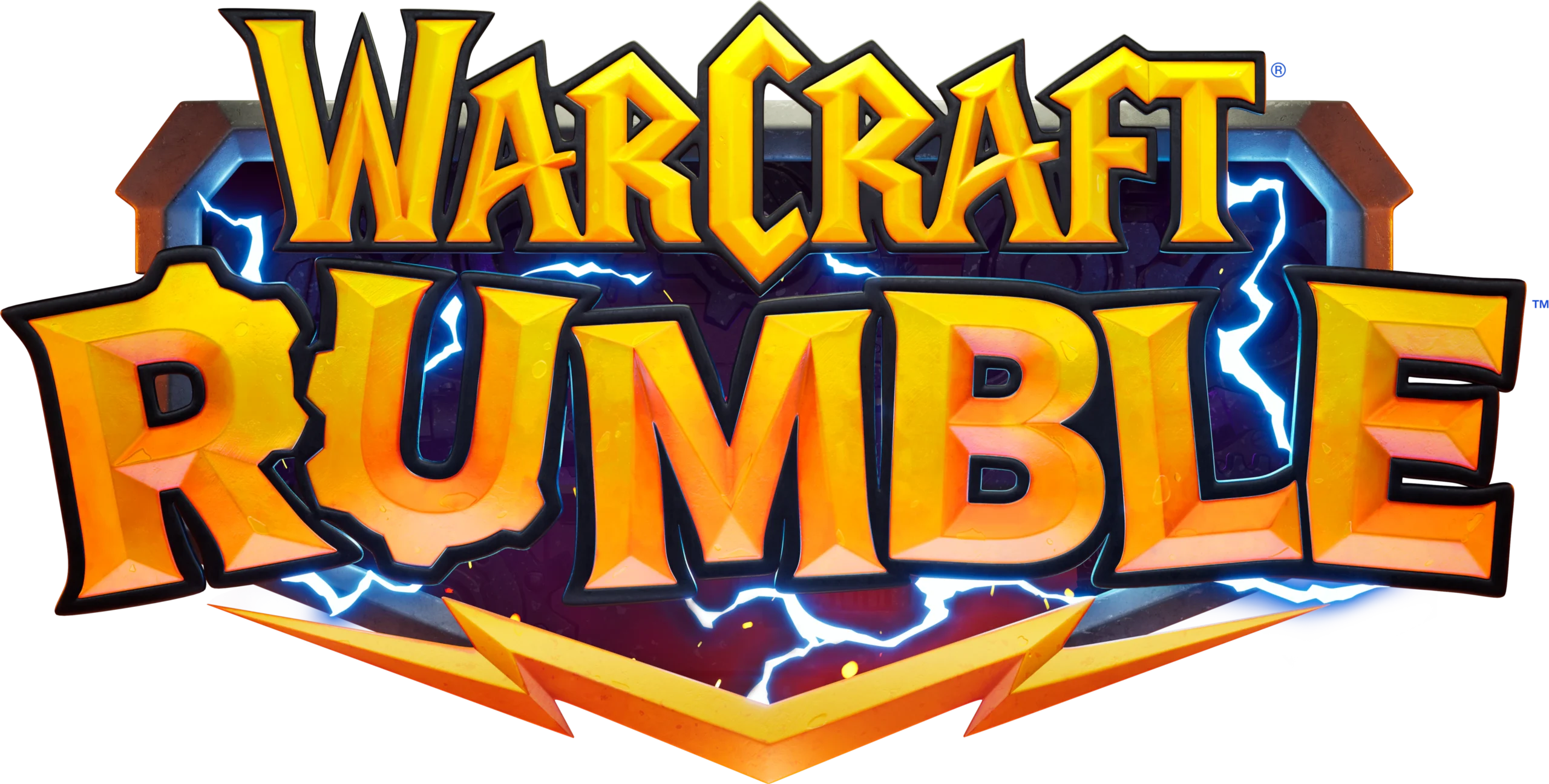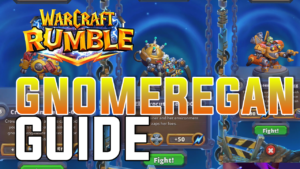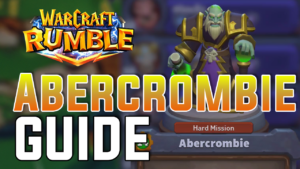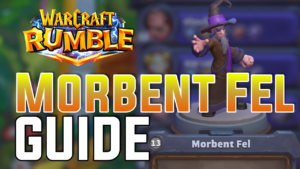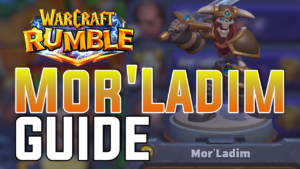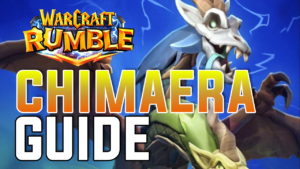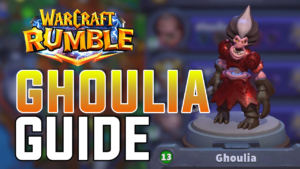Table of Contents
Warcraft Rumble, the latest Blizzard game, is presented with a significant PvE mode one can explore and try to defeat in their own time. However, in reality, you will also need to master the PvP mode, at least a little, in order to keep progressing in the game. Indeed, even through farming the quests, upgrading your cards can take quite a bit of time once you start reaching bosses higher than your card's level. This is where managing to play the PvP mode can be extremely important, as it will help level your cards faster, but also present a different challenge.
In this article, I will guide you through the basics of Warcraft Rumble's PvP mode, which you can consider to be until you reach a score of at least 3,000 on three different leaders, then, the difficulty will truly start, as the level of your cards will start mattering much more. Up until that point, it is mostly skill, and learning how to correctly use your units, and interact with the opponent, which can be quite the challenge already.
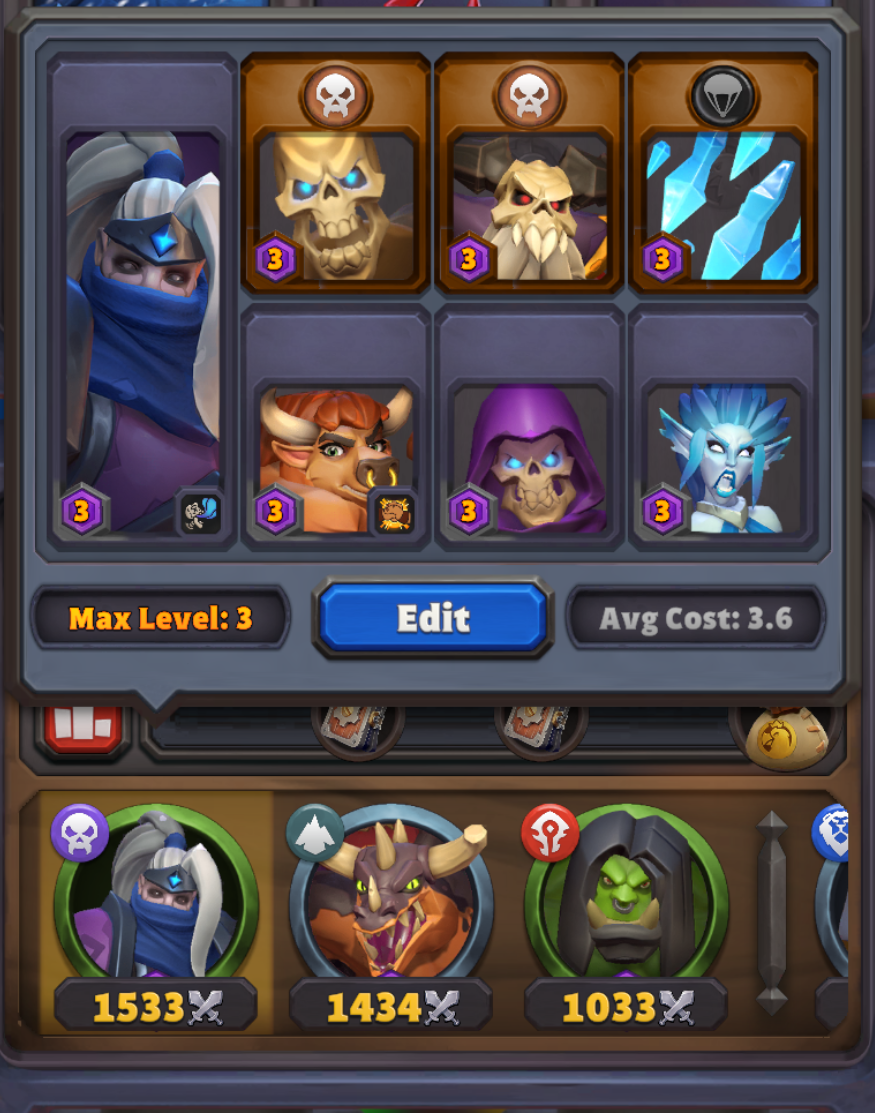
Indeed, until that point, you can play on an even ground (barring their talents, we'll get to that later) as long as your cards are level 9 to 15 depending on your rank, which should be achievable through playing PvE, PvP, and quests. If you can't level up enough cards, you can keep a similar core of cards for PvP, and only changes to the leader alongside a couple of synergistic options. This way, you can dive into PvP with less than ten cards leveled to 9, at least until you reach the 2,000 ranked score floor.
How PvP Works
In the early stage, your goal will be to master three different leaders, as PvP will add their score to create your player's ranking, and progress through the various ranks. Doing so, you can play much longer at the same level of play, rather than hitting a ceiling pretty quickly on the same leader, and feeling frustrated as a result.
Also, even if your three best scores add up, each leader is playing based on the rules of their own rank. Then, if there is a leader you are particularly strong with, it won't impact your experience on the others, which you might struggle a little more using.
There are many benefits to this system when it comes to upgrading your cards and developing as a player:
- Winning PvP games is one of the fastest ways to level your cards. Pick a 4th leader you do not care about its ranking, and just spam PvP games to upgrades the cards you want. This is particularly effective with strong standalone cards you can fit in many decks, like or .
- You can practice combination of cards, outside of leader synergies, with any leader you like. As such, when you feel you found a good combination amongst your cards, you can use a leader with a bad rank to test it out, and see how it feels before including it alongside the leader whose ranking you care about.
- You can climb with more than three leaders, and create a situation where if you get a bad streak on one, it won't impact your global rank. Indeed, that leader would just fall off your top 3 but you had others at a very similar rank already.
Warcraft Rumble will unlock rewards as you reach certain thresholds, based on the combined score of your three best leaders. This means you can have one leader at 2.000, and two at 500, bringing your overall rank to 3,000, same as if your top three all had 1,000 ranked points. In such situation, the game will award you the rewards of a rank 3,000 player. This is critical to understand, as it means you can reach a decent overall score, even if you invest in one leader only.
The Basics to Become a good PvP Player
Dominate the economy war
We have to pay for our units, and typically, the player who plays the most over the cost of the game will quickly leverage a better position. Then, controlling the gold income will go a long way into simply being able to dump units and let the opponent deal with our multiple waves of attack.
There are two ways to win over the gold battle:
- Mines: Controlling the lane where the mines are will allow your Kobolds to mine quietly. Usually, it is ideal to routinely check the lane, and maybe send a cheap unit to make sure the path is cleared for our Kobold, alongside annoy opposing Kobolds as well.
If you are playing Dark Iron Miner (you should, it's a great mini), mines basically becomes like Chests, as you don't need to escort your Kobold there every time. You will need to protect the Dark Iron Miner though, but it's much easier to do than saving a Kobold most units will one shot.
Through pushing a specific lane using the - Chests: They contain two gold each, and will go to whoever has a unit alive when they open. From a basic mathematical standpoint, if you invest four or less gold, then the chest is worth it, as we get 2 golds for it, and deny our opponent 2 potential gold as well, especially if your unit stays alive and contributes to battle duties, which is just a net positive then.
If both players have a unit in the zone, the units will battle before the chest is allotted to either one with a unit left in the zone after battle.
In both cases, the ideal scenario is to be the one pushing the opponent to defend, which will place the chests and mines on our side of the battle field. Then, our units will naturally collect chests or protect mines for us, while you need Unbound figurines to go fight for one which isn't in a zone under your control.
Use the Switches on the map to guide your units and make them go through Mines or Chests, making sure you naturally control these areas. Or push through a different lane to force your opponent to defend there, while you collect gold safely on the other lane. This second strategy typically works best with Dark Iron Miner for Mines, and fast or Unbound units for Gold Chests.
Constantly scan the playing field
We get little indicators as to what our opponent is summoning, or when our base is under attack in the corners of the screen. However, gold mines and chest are also a very important part of winning a PvP, and so is knowing where opposing units are, alongside ours.
With that in mind, whenever you have nothing pressing to do, have a little look over the map, just to make sure nothing has slipped or mind, or there aren't any gold we could easily claim that we're missing out on. Also, it is easy to see a unit be summoned and forget about it five seconds later as we were focused somewhere else, and then see our base lose health as a result.
Know the popular, strong standalone cards you will likely see the most
Whelp Eggs, S.A.F.E. Pilot, Murloc Tidehunters , Huntress, Darkspear Troll, ProwlerAbove are the six of the most commonly used card at the time of writing this article. I could have added to the list as well, or Dark Iron Miner, Griphon Rider to name a few. They all share some common traits, such as being quite fast, which helps for being reactive, or gunning for a gold chest. The only one on the expensive side of things with five gold, is the .
We could also look at the interaction between each card to get a feel of the most interesting ones to run. For example, is strong against the , but miserably fails against the , which are killed by the .
Typically, if the type of cards you see the most - here it would be rather quick, damage based cards with a cheap or average price in order to control the Gold Chests - will give you are lot of information about the general metagame.
The Basics to Build a Good PvP Deck
Note: All decks shown here are just examples to showcase the concept behind it. We have an article dedicated to the best PvP decks below!
Typically, you would want three things in your deck going into a PvP match:
- Reactivity: Cards able to quickly act against, or in anticipation to your opponent, such as Spells or Unbound units we can summon anywhere on the field. Their cost price will also be a big component of being reactive. The more expensive the card, and the less likely we are to deploy it at any time in the match.
- Flexibility: The ability to summon all over the field is huge in PvP, especially to control gold chests, deal with opposing units you could counter, or push a base when some of your units got through. Similarly, you want to be able to answer most kind of units, particularly the flying or fast ones, which can quickly get to your base if they are left alone.
- Synergy: Your leader will push your deck in a certain direction. However, there are some strong standalone cards a lot of decks can include, such as the , and provide a cohesive core to your deck.
There are multiple strategies you can go for in Warcraft Rumble, whether it is trying to rush down your opponent, to play defensively and build your lead, or work with waves of specific units. Yet, these three basics are important to keep in mind at all time. So how do we make sure we got the right ingredients?
We have ask the critical question: What am I trying to do?
Aggressive Decks: Aiming for the opponent's base
- Reactivity: Our goal here is to focus on the opponent's base, and we are looking for ways to make sure we hit it regularly, and maybe slow them down while we do so. Spells will be great to slow the opponent's army while we push the other way, or brute force our way through if we meet their army.
- Flexibility: Once we start the damage on the opponent's base, we don't want to give them too much time to recover. Then, we need cards we can summon directly close to their base to keep dealing damage and finish the job.
is a good example of a card which can quickly join your troops and focus on the base. You can also directly summon or a for example. These cards can also help grab the gold chests before our opponent, as we summon a card directly on them. - Synergy: You probably want a leader focusing around siege damage, such as , flexible in where it summons in , very fast with , or to tank the damage for your other units and also touch the opponent's base when fighting close to it.
Cairne Bloodhoof Example PvP Deck
cairne-bloodhoof-deck-f43orand serve as tanks, with to hide behind to clean groups of units. Then, we have and to push the opponent's base, with and to help both groups depending on the situation.
Old Murk-Eye Example PvP Deck
old-murk-eye-deck-whzztYou could also go for a full cheese deck built around cheap units protected by and to help them get some damage on each of their rush.
Midrange Decks: Looking to dominate through battle
- Reactivity: We want to be able to support our units in battle, either sending new ones quickly, such as , healers in , or have spells to make sure we emerge the winner of that battle. We can also play units with AoE damage to dominate the fights. , or are solid in that regard.
- Flexibility: Unless is your leader, you can't really stack all your units in the same place, unless you want to open yourself to your opponent's spell. Then, you might need units with different speed, so you can space their summoning, or ranged units who can shoot from afar.
- Synergy: Winning in battle means you trust your units to be able to reliably beat your opponent's units when they face each other. It can be because you deal more damage, or because you can withstand more. Your leader should reflect this idea that you will accept to take your opponent head on multiple occasions during the match.
General Drakkisath Example PvP Deck
general-drakkisath-example-pvp-deckGeneral Drakkisath boosts your Elemental Damage by 50%, which will make your spells devastating. Then, if you can enter the battle with five gold stored, you can use both S.A.F.E. Pilot and Chain Lightning to support your units, and emerge victorious. Polymorph plus Chain Lightning would also work wonderfully.
Tirion Fording Example PvP Deck
tirion-fordring-example-pvp-deckAbomination allows protecting our units while bringing opposing ranged units in battle. Then we can support it with both Tirion Fordring and Frostwolf Shaman to have a very resilient group of units.
S.A.F.E. Pilot, Harpies, and Gryphon Rider are used to take care of flying units and support the group.
Gold Decks: Looking to win the economy war
- Reactivity: The whole point of our strategy is to control the flow of available resources. We need to be quick on the gold chests and mines, alongside able to defend our base on short notice if the opponent decides to rush it.
- Flexibility: We need to be able to constantly be annoying to our opponent, controling both the gold chests and mines. Roaming units and the ability to summon directly on Chests will be crucial to make sure they can never collect gold on their own terms.
- Synergy: We require a mix of cards able to both move quickly to control the available gold on the field, and protect our base as we'll accept the opponent will get close to it on several occasions, as we are focusing on the gold more than the base early on.
Baron Rivendare Example PvP Deck
baron-rivendare-example-pvp-deckSummoning Skeletons is great to control the mines and waste our opponent's time to kill them. Baron Rivendare is fast, so it can pressure the opponent quickly and go for gold chests. Necromancer summons Skeleton to keep opposing units busy on defense.
Then, we can use Harpies for ground units, S.A.F.E. Pilot and Necromancer for flying units. Blizzard for emergency situation.
Talents Are a Big Part of PvP
If the game is made in a way that all players should play with cards of the same, or very similar level, talents are a different story. In order to unlock a talent, you need to purchase it from the store once you upgraded your card to the next rarity level.
Talents can be added to any card, and will make your card much more powerful, no matter the cap level imposed to your leader. Simply put, a deck with seven "talented" cards will typically demolish a deck without talents attributed. It is unclear at this point whether matchmaking is trying to pair you with decks with a similar amount of talents or not.
Because talents can be so impactful, they will often impact your strategy a lot, and lead to the card being worth to include in every single deck you will play. Also, if you add a talent to a leader, it will help said leader become much more powerful. For example, adding Death Pact to makes it much more difficult to kill, and raise the stock of a Skeleton oriented deck. Unfortunately, this also means you increased the power of one leader only. On the other hand, if you can find a strong standalone card, and add it to each of your decks, you might have helped your overall rank more than with the choice to boost one single Leader.
This choice will obviously impact your experience quite a bit, as boosting a leader is better if you are trying to play PvE, or only care about one leader's rank until you get it to 2,000 and then change until you can get your cards to level 15, or even rank 3,000. Otherwise, if you are looking to play a variety of leaders, it might be better to target cards you plan on playing with several leaders in PvP shortly.
Here are some ideas of solid talents to pick for standalone cards:
- : Both Momentum and Pummel are great
- : Jeweled Skulls
- : Safety Bubble
- : Gnomish Cloaking Device
- : Mighty Throw or Odin's Fury
- : Pick Lock or Last Resort
- : Flame Burst
- : On The Prowl
- : Big Bad Voodoo
- : Gold Mine
As for leaders, if you wish to invest into a specific one, feel free to check our dedicated guides to each leader on this very website.
Closing Words
This guide isn't the answer to becoming the best PvP player in Warcraft Rumble - that will probably take more than reading a few articles unfortunately. However, I believe the fundamentals are the most important part of learning any kind of skill. Once you have that foundation, you can put it your own twist, and develop your own playstyle, which will take you much higher than the 2,000 or 3,000 rank floor.
I hope this guide helped you pick up a few of these fundamentals, which might make you feel more ready to tackle PvP now. I wish you a lot of fun with Warcraft Rumble, and may your next PvP sessions be successful.
Good Game everyone.
